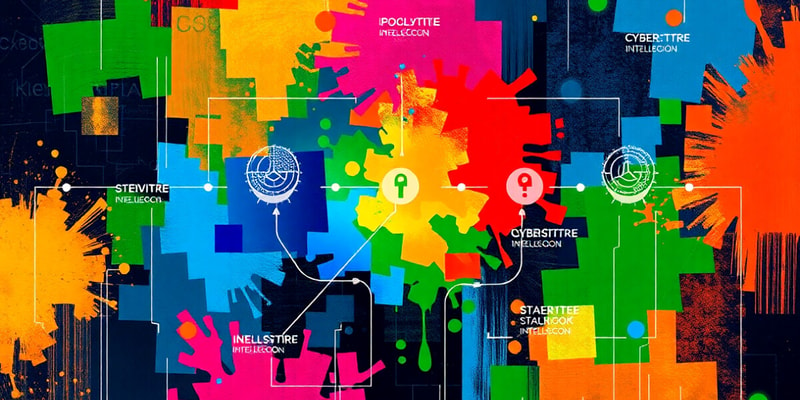Podcast Beta
Questions and Answers
What is the primary benefit of vendors aggregating data from multiple customer environments?
Which of the following is a typical product line for vendors in the cybersecurity space?
What type of intelligence is primarily collected by vendors in the cybersecurity industry?
How does aggregated data from multiple customers assist vendors?
Signup and view all the answers
What are high-fidelity observables primarily used for in cybersecurity?
Signup and view all the answers
Which of the following products can be created from the insights derived by vendors?
Signup and view all the answers
What role does a URL associated with a credential harvesting site play in network defense?
Signup and view all the answers
What could positive hits on a URL related to ransomware indicate?
Signup and view all the answers
What phase follows the collection phase in the intelligence lifecycle?
Signup and view all the answers
Which type of intelligence is NOT categorized under the broad categories discussed in the module?
Signup and view all the answers
What is the primary focus of the collection phase in the intelligence lifecycle?
Signup and view all the answers
Which of the following best describes the purpose of the analysis and production phase?
Signup and view all the answers
How does understanding collection sources support the intelligence process?
Signup and view all the answers
What is the ultimate goal of the dissemination and feedback phase?
Signup and view all the answers
Which of the following phases involves turning data into analytic assessments?
Signup and view all the answers
What is a critical element that should be reviewed before starting the collection module?
Signup and view all the answers
What do TTPs stand for in the context of threat actors?
Signup and view all the answers
Why is it difficult for threat actors to change their TTPs?
Signup and view all the answers
What is a key benefit of understanding threat actor TTPs for organizations?
Signup and view all the answers
What factor should organizations consider when selecting a vendor for cyber intelligence?
Signup and view all the answers
What is the primary role of initial access brokers in cybercrime?
Signup and view all the answers
What is a requirement for effectively using external telemetry and forensics-based intelligence?
Signup and view all the answers
What can be inferred about vendors based in Canada selling email security solutions?
Signup and view all the answers
How do CTI teams utilize intelligence related to compromised systems?
Signup and view all the answers
What approach do vendors often take when dealing with threat actors selling compromised resources?
Signup and view all the answers
What should organizations do if they lack stakeholders with behavior-based threat hunting skills?
Signup and view all the answers
Which application of cybersecurity intelligence is emphasized for assisting network defenders?
Signup and view all the answers
What is one key aspect of the information provided by threat actors about compromised resources?
Signup and view all the answers
In what way do threat actors utilize deep and dark web forums?
Signup and view all the answers
What is a critical caution to consider when assessing intelligence from threat actors?
Signup and view all the answers
What kind of emerging threats can threat actors discuss or sell on forums?
Signup and view all the answers
What should organizations be wary of regarding the sources of intelligence derived from the web?
Signup and view all the answers
What type of intelligence includes data collected from internal sensors and logs?
Signup and view all the answers
Why is internal telemetry and forensics-based intelligence often considered difficult to leverage?
Signup and view all the answers
Which of the following best describes the primary purpose of contextualized security alerts?
Signup and view all the answers
What is a major limitation of the log data generated by network components?
Signup and view all the answers
What is the potential advantage of correlating internal telemetry with external intelligence sources?
Signup and view all the answers
What is considered the 'holy grail' for many cyber threat intelligence (CTI) teams?
Signup and view all the answers
What challenge do CTI teams face when analyzing data from diverse applications?
Signup and view all the answers
What type of intelligence is most often the most difficult for CTI teams to leverage?
Signup and view all the answers
Study Notes
The Intelligence Lifecycle
- The intelligence lifecycle is a five-phase process outlining the core workflows of cyber threat intelligence (CTI) teams
- The five phases are requirements & planning, collection, processing & ingestion, analysis & production, and dissemination & feedback
- The collection phase focuses on gathering information and data for intelligence purposes
Types of CTI
- CTI is categorized into three broad categories:
- Clear, Deep, and Dark Web Intelligence
- External Telemetry and Forensics-Based Intelligence
- Internal Telemetry and Forensics-Based Intelligence
Clear, Deep, and Dark Web Intelligence
- This type of intelligence is obtained from various online sources, including forums and marketplaces
- Threat actors use these platforms to advertise compromised systems, sell access, and recruit others for operations
- It’s crucial to approach this intelligence with skepticism, as threat actor claims can be inaccurate or exaggerated
- Key applications: Understanding emerging threats, tracking new malware and tools, and identifying plans and intentions related to specific operations or industry verticals
External Telemetry and Forensics-Based Intelligence
- This intelligence is typically collected from cybersecurity vendors that develop, deploy, and manage technical solutions and applications
- Vendors often have deep visibility into threats impacting the systems and applications their solutions are designed to detect and mitigate
- Key applications: Providing high-confidence technical insights on threats, delivering observables and indicators of compromise (IOCs) for network defense, threat hunting, and attribution
- It can also provide technical analysis and detection rules for malware samples, detailed analyses on threat actor tactics, techniques, and procedures (TTPs), and insights on threats affecting specific organizations, regions, and technologies
Internal Telemetry and Forensics-Based Intelligence
- This type of CTI encompasses data collected from internal sensors, security appliances, applications, logs, and post-incident forensics
- Internal data can be analyzed individually or correlated with external intelligence for enhanced insights
- Challenges in leveraging internal data: Different data elements and components requiring custom parsing and processing, large amounts of irrelevant data among logs and alerts
- It is widely considered the 'holy grail' of CTI, as effectively integrating and leveraging it can provide extremely valuable and relevant threat insights
Studying That Suits You
Use AI to generate personalized quizzes and flashcards to suit your learning preferences.
Related Documents
Description
Explore the foundations of Cyber Threat Intelligence (CTI) through the intelligence lifecycle, which encompasses five critical phases. Learn about the different types of CTI, including Clear, Deep, and Dark Web Intelligence, and understand the importance of skepticism in evaluating gathered data.




